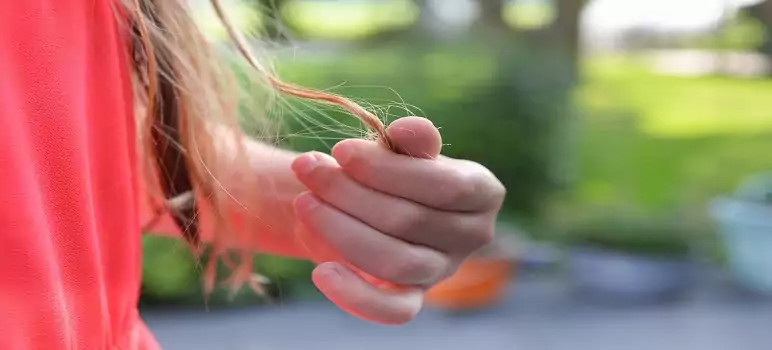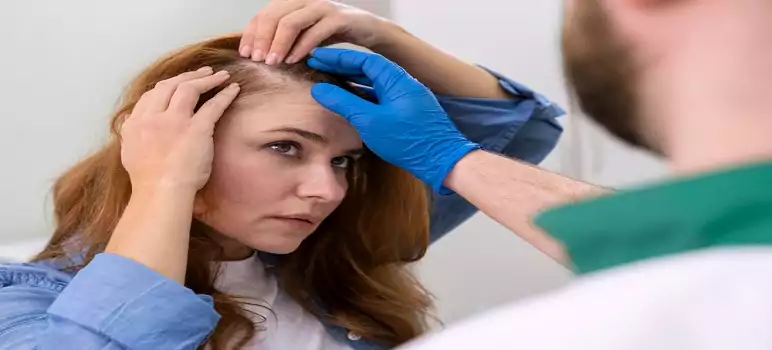Causes of Hair Loss in Women: If you are women, facing hair loss and you have tired so many treatments but nothing works, you are landed at the right page because in this article you will get to know the causes of hair loss in women and by knowing them you are prevent them as well.
Hair loss can be distressing at any time in your life. But for many women, it’s a source of particular anxiety as they progress through their 20s and into their 30s. As you may have read or heard somewhere recently, this is supposedly the peak age for hair loss in women. According to some sources, that’s because of increased stress levels, the strain on our hair from chemical processes and heat, and other “newer” factors like genetics and diet.
Even if you don’t believe this new information about the causes of hair loss in women, it’s still something you should be aware of as part of an informed decision-making process regarding how to handle thinning hair. Let’s take a look at what we know so far about the potential Causes of Hair Loss in Women —and how you can stop it.

Here are 6 causes of hair loss in women- Hair Fall Reasons
1. Changes and imbalances in hormones
Hormonal changes can impact hair growth, regardless of whether you just had a baby or stopped taking a birth control pill. Your hair becomes thicker and fuller when your estrogen levels are higher. Hair thinning occurs when estrogen levels diminish. Fortunately, when your body gets used to your new estrogen levels, hair loss should halt.
Progesterone can aggravate or induce hair loss, whereas estrogen promotes hair growth. The following are some well-known progesterone-based birth control pills linked to hair loss:
- Nexplanon-style implants
- Depo-Provera, the contraceptive injection
- Xulane birth control patches
- The vaginal birth control ring NuvaRing
Women who have medical conditions that lead to hormonal imbalances are also more likely to have hair loss. Examples include congenital adrenal hyperplasia, polycystic ovarian syndrome (PCOS), and hypothyroidism.
If you experience symptoms like: Your doctor may perform a hormone test to determine if you have one of these problems in addition to hair loss.
- Growth of new hair on body and face
- Difficulty with weight gain or loss
- Irregular periods
- Difficulty tolerating temperature changes
- Hormonal pimples
When you stop using the birth control, your hair loss should stop if it is caused by a progesterone-based birth control. Finding and addressing the imbalance is necessary for regrowth if the problem is a hormonal one.
You may also like:
- What are the main Causes of High Blood Pressure & How to Prevent it?
- Causes of Migraine in Male, Female- Types of Migraines and Symptoms, treatment
2. Stress/tension
Causes of hair loss in women: Women who experience stress are more likely to experience hair thinning. Your body may go into “survival mode” as a result of them, when it limits fuel and energy to support the functions that are most important to it.
Each hair follicle cycles between the growing and resting states. Hairs are forced out of the growing phase and into the resting phase by a stressed body, which finally results in hair loss. Telogen effluvium is the medical term for this type of hair loss.
In telogen effluvium, hair losing may begin 3 months after a very stressful incident and last for 3 to 6 months. But stress-related hair loss won’t result in you being bald. Most people observe regrowth 3 to 6 months after the tension has subsided. The full correction can take anywhere between 12 and 18 months, depending on the length of your hair.
The American Academy of Dermatology lists the following as causes of stress-related hair loss:
- Surgery
- Pregnancy
- Bereavement
- Relationship breakup
- Medication alterations
- Extreme loss of weight
3. Genetics
Genetics is the most frequent cause of hair loss in both men and women. One or both of your parents may have passed on the hair loss gene to you.
Hereditary hair loss in women typically begins after the age of 40. By the age of 50, almost 40% of women suffer visible hair loss. And fewer than half of women have a full head of hair when they are adults.
Compared to men, women’s hereditary hair loss has a slightly different appearance. Your portion may be broader or your hairline may be higher than it used to be. In the majority of women, hair thinning develops gradually over years, but if left untreated, it might affect the entire scalp.
Compared to men, women often lose less hair. But it’s crucial to recognise that, in comparison to men, women often experience lower levels of socialisation and a lower quality of life due to hair loss. Fortunately, early treatment can usually stop and even reverse the process.
4. A harmful hairstyle
We frequently pay the price for our actions when we were younger as we get older. This could refer to all the painful hair styling we underwent in our 20s and 30s. Inflammation is brought on by relaxants and hot combs. Hair roots are compressed by tight ponytails, weaves, and braids.
These procedures hurt the hair follicles, which can result in scarring and eventual hair loss. The first indication of styling-related harm could be hair loss or thinning at the top of the scalp.
5. Old aging & infections that cause hair loss
Causes of hair loss in women: As genuine as skin ageing is, hair ageing starts in your 60s. Individual grey or white hairs become fewer and thinner, and it takes longer for them to regrow after falling out. Aging-related hair loss affects everyone, unlike hereditary hair loss, which has a larger portion and receding hairline.
You may also like:
- What happens when you stop taking birth control Pills- 10 Surprising Facts!
- What do energy drinks do to your body- All you need to know!
Ageing hair can be increased by sun damage. Similar to skin pigment, hair pigment has a protective purpose. UV (ultraviolet) radiation can more easily damage grey or white-colored hair. Damage can be avoided by wearing helmets and using sunscreen-infused hair products.
6. Health issues- illnesses that cause hair loss in females
Hair loss can be influenced or caused by medical problems. In instance, dietary deficiencies, anemia, and hypothyroidism—all of which are more prevalent in older people—can result in hair loss.
In addition, hair loss is a known side effect of cancer and cancer treatments. A year after finishing therapy, the majority of people will regrow their lost hair, though it’s typical for their hair to become grayer or whiter.
Treatment of Hair Loss in Women

Use shampoos for hair loss
A little amount of hair loss could occur as a result of clogged scalp pores. Using medicated shampoos made to remove dead skin cells from the pores may aid in promoting healthy hair. This might assist eliminate early hair loss symptoms.
Eat a balanced diet- Best Hair Loss Treatment for Female
A healthy diet may also help regular hair growth. A healthy diet often includes a wide variety of foods, including numerous fruits and vegetables. These contain a variety of vital nutrients and other substances that support healthy skin and hair.
Hair health may also be influenced by iron levels. Women who are experiencing hair loss might visit their doctor for a blood test to determine if they are iron deficient. A doctor might suggest taking an iron supplement or eating a diet high in iron.
Platelet-rich plasma
Injections of platelet-rich plasma, according to preliminary research, may also help stop hair loss. A doctor will draw the patient’s blood, separate the platelet-rich plasma from the blood, and inject the plasma-rich solution back into the scalp at the afflicted locations. This facilitates quicker tissue healing.
Hormone therapy
Doctors may advise a type of hormone therapy to treat hormone imbalances that lead to hair loss, such as those brought on by menopause. Birth control pills and estrogen or progesterone replacement therapy are two viable treatments.
Other possibilities include the use of antiandrogens such spironolactone. Androgens are hormones that, in some women, especially those with polycystic ovarian syndrome who normally produce more androgens, can hasten hair loss.
Antiandrogens can halt androgen production and stop hair loss. Always consult your doctor about what to expect and whether antiandrogens are appropriate before taking these medications as adverse effects are possible.
Corticosteroids
Additionally, some females may react to corticosteroid injections. Only when absolutely required, such as for disorders like alopecia areata, do doctors utilise this medication. When a person has alopecia areata, their hair flakes out in haphazard patterns.
The National Alopecia Areata Foundation claims that injecting corticosteroids right into the hairless region may promote the growth of new hair. However, this might stop other hair from thinning. Hair loss may also be decreased by topical corticosteroids, which are sold as creams, lotions, and other preparations.
Hair transplant in women
Doctors may advise hair transplantation in specific situations where the patient does not respond well to therapies. This entails shaving off a little portion of the scalp and applying it to the bald spots to naturally thicken the hair there. Hair transplant therapy is not appropriate for everyone and can be more expensive than other therapies.
You may also like:
- 12 Most Common Causes of Kidney Stones and How They Are Treated
- 5 Ways to Keep Your Lips Protected During the Cold, Dry Winter Weather!
How can women prevent hair loss?
Causes of hair loss in women: When hair loss is caused by illness, ageing, hereditary, or physical stressors like injuries, it is impossible to prevent. You can stop hair loss caused by caustic chemicals or tight hairstyles simply by avoiding them. By eating a nutritious diet that contains the required elements in the form of vitamins, minerals, and protein, you may be able to stop some hair loss.
Frequently Asked Questions
Which vitamin deficiency causes hair loss?
Iron, Vitamin-D, Selenium and Zinc
Which lack of vitamin causes hair fall?
Vitamin D
What is the most common cause of hair loss?
Hereditary condition or genetics